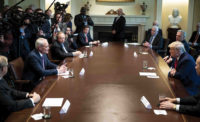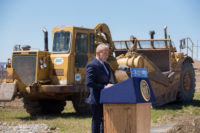Construction companies large and small and even individuals are making plastic face shields to help augment the dwindling supplies of personal protective equipment for health care workers.
Daniel Lax, a 2012 ENR Newsmaker, has converted production at his company, Clear-Vu Lighting, to make PPE face shields. So far, the company has produced more than 100,000 shields.
“A local hospital came to us for help,” Lax says. “One of our business customers is NYC Transit, and they have 50 people who died so far.” Because Lax and his team have friends and family who have died from COVID-19, “It hits a personal vein,” he says. The Clear-Vu face shields are a two-piece assembly with integrated foam. “For our business, we learned a new capability.”
[For ENR’s latest coverage of the impacts of the COVID-19 pandemic, click here]
Others are using 3D printers and laser cutters to make the shields. In less than a week, Cornell’s College of Architecture, Art and Planning has turned its entire digital fabrication lab into a facility for face shields using a design that was verified by Weill Cornell Medicine. Other labs across campus and Cornell alumni at Handel Associates, KPF, BIG, Grimshaw and Terreform have also joined the effort.
A request from two New Jersey hospitals was the catalyst for engineering students and faculty at Rowan University in southern New Jersey to design and distribute free 3D-printed face masks.
The masks are the brainchild of Ben Saracco, research and digital services librarian for Cooper Medical School at the university, Shreekanth Mandayam, on the faculty of Rowan’s electrical and computer engineering department and George Lecakes, a Ph.D. engineering student and director of Rowan’s Virtual Reality Center.
The washable, reusable masks were adapted last month from a design shared online by Billings Clinic Foundation in Montana after Lecakes' initial prototype didn’t seal well. Rowan modified the Billings design to be a cup-shaped mask printed from spools of plastic and fitted with a removable filter.
Rowan’s masks are being tested at Cooper University Health Care and Inspira Health systems hospitals in southern New Jersey, with the school planning to manufacture 100 per day.
General Electric Co. is using 3D printing to produce an adapter that can quickly convert a standard hardhat and visor into a face shield to protect the masks worn by health professionals treating patients. “It fits onto almost any combination of hat and shield,” says Josh Mook, an engineering executive at GE’s 3D printing unit. He says it also allows the wearer to easily raise and lower the visor. Printing the adapter takes about 15 minutes, he says.
John Deere, working with the United Auto Workers, started producing face shields on April 8 in Moline, Ill., and expects to produce 25,000 shields initially; the company has ordered supplies for up to 200,000 face shields.





Post a comment to this article
Report Abusive Comment